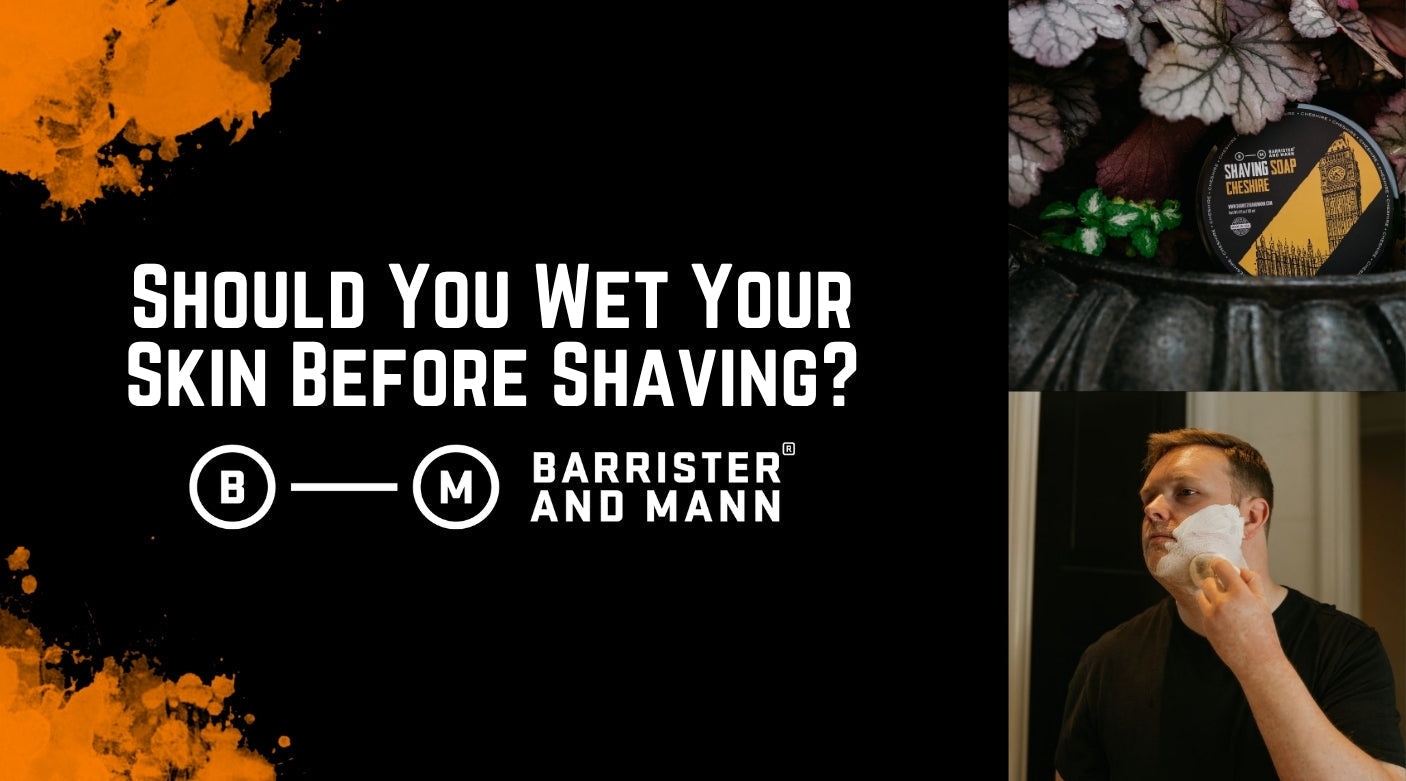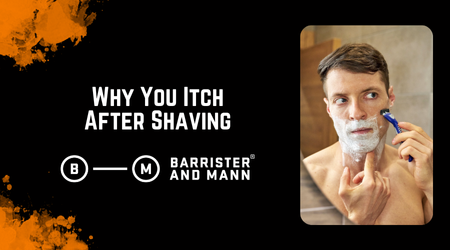Dry hair resists the blade. Hair that is wet cuts cleanly. Starting with water softens the hair, hydrates the skin, and makes every part of the shave easier, closer, and less irritating. Without it, even the best razor will struggle.
-
Wetting softens the hair and skin: Water hydrates the outer layer of skin and swells the hair shaft, making it easier for the blade to cut cleanly. It also helps the skin flex, reducing resistance and friction.
-
Washing clears out oil and bacteria: Skin collects sweat, dead cells, and microscopic grime. Shaving without washing drives that gunk into pores. A clean canvas gives a cleaner shave.
-
Shaving after a shower is ideal: Steam hydrates the skin and softens everything. You are never better prepped than right after stepping out of a warm shower.
-
The body part you’re shaving still matters: Facial skin needs more prep than your legs. Coarse beards and sensitive skin demand extra attention. What works on your head may not work on your jaw.
-
There is no substitute for proper prep: A splash of water is not enough. A ten-second rinse does not count. The goal is softened hair and hydrated skin, not just getting wet for the sake of it.
Wetting vs. Washing
Water is not just for rinsing after you finish. It is the first step in controlling how your hair and skin behave under the blade.
When hair absorbs water, it swells and softens. This makes it far easier to cut cleanly. Less resistance means less tug. Less tugging means fewer chances for razor burn or uneven spots.
Hydrated skin also stretches more easily, which helps the blade move without catching. It is the small, invisible things, like how taut the skin is or how plump the hair shaft becomes, that make the difference between a passable shave and a great one.
Why a Wash is Important
There is no good reason to shave over dirt. Oil, dead skin, sweat, sunscreen, and yesterday’s moisturizer all clog the blade and gum up your lather. Worse, they can get pushed into pores and micro-cuts, raising your odds of irritation or breakouts.
Washing removes what should not be there and makes room for the products that should. A clean surface lets your lather sit where it needs to. It improves glide and helps the razor track evenly without skipping.
When to wash
Always wash before you shave. Not after. That time has passed. Cleansing before shaving gives your skin the best shot at staying calm. It also gives your lather a fighting chance.
Shaving opens the skin. Washing after shaving means scrubbing over freshly exfoliated and possibly abraded skin.
Use the gentlest cleanser you have. Your usual nighttime wash is probably fine unless it’s loaded with exfoliating acids or gritty particles like microbeads. Shaving is already exfoliating. You do not need to add more abrasion to the process.

Dry Skin, Dull Blades, Bad Shaves
Dry hair is hard to cut. It resists the blade and pulls against the skin. That pull is what causes tugging. Tugging leads to razor burn, red patches, and uneven results. The blade skips. The skin reacts. And you end up chasing smoothness with more pressure, which only makes things worse.
Water fixes that. It softens the hair so the blade can cut cleanly without a fight. It also helps the skin flex beneath the blade, which reduces drag and protects the surface.
Warm water makes everything work better
Shaving products are designed to work with moisture. Warm water helps the lather adhere, bloom, and build structure. It lets your brush do its job and activates the ingredients in your soap or cream.
A wet face grips the lather. A dry face repels it. Without that water barrier, your lather slides off or breaks apart.
There is a difference between getting wet and getting hydrated. Splashing water on your skin before shaving feels like doing something, but it does not achieve much. It neither softens the hair nor prepares the skin. All it does is give the illusion of prep without the results.
Face, Legs, Head, and Beyond: Does the Body Part Change the Routine?
The spot you are shaving changes how your skin responds, how your hair behaves, and how much prep you need. Not all hair grows the same. Hair on your head grows differently from that on your legs; both are different from what grows on your face. Each area brings its own texture, density, and sensitivity to the table.
Facial Hair Needs Serious Prep
Facial hair is a different animal. It grows thicker, denser, and closer to sensitive nerve endings. It also tends to be coarser and curlier, especially for men of color, which increases the risk of ingrown hairs and razor bumps. That means it needs more than a rinse.
Hydration softens the structure of each strand and loosens its grip at the follicle. A well-hydrated beard cuts cleanly instead of pulling and tearing at the skin.
Shaving Your Head or Legs
Head and leg hair is usually finer, and the skin underneath is less reactive. You can often get away with simpler prep, but the fundamentals still apply. Hair needs to be soft. Skin needs to be clean. Lather needs to stick.
What changes is the margin for error. The scalp can take more pressure. Legs can tolerate a colder rinse. But if you ignore prep altogether, the blade will remind you why it matters.
-
Body skin tends to be less prone to razor burn: That does not make it immune.
-
Cooler water may still work below the neck: But warm water remains the gold standard for a reason.
Shaving Your Armpits
Armpit hair grows thick and changes direction without warning. The skin is soft, folds easily, and reacts quickly to pressure or friction. That makes it one of the easiest spots to irritate if you rush the prep.
-
Wash well before shaving: Sweat, deodorant, and antiperspirant are not things you want to push into freshly shaved skin.
-
Use warm water to soften and clean: Give the area time to loosen up and clear the surface.
-
Shave gently and follow the grain: Press too hard and you will feel it later.
-
Moisturize afterward: This is high-friction territory. Keep the skin calm or it will let you know you messed up.
Cold vs Warm Water Shaving: What’s Better for Your Skin Type?
There is no one right way to shave. Skin types vary. So do hair textures, environmental factors, and personal routines. One person's perfect prep is another’s fast track to razor burn. The temperature of your water plays a bigger role than most people realize.
Both cold and warm water have their place. The key is knowing when and why to use each.
Cold Water Shaving Is Calmer but Less Forgiving
Cold water tightens the skin and helps reduce redness. It keeps swelling down and can feel more soothing, especially for people with acne-prone or reactive skin. If your skin flares easily, cold water might give you a calmer start.
But it comes with tradeoffs. Cold water does not soften the hair well. This applies whether you’re shaving your face, your head, or anywhere else. If the hair is coarse, the blade will drag more. That means more friction, not less.
-
Use cold water if inflammation or acne is your biggest concern
-
Avoid it if your hair is thick or grows close to the skin
Warm Water Shaving Gives the Best Overall Performance
Warm water softens hair. It hydrates skin. It helps the blade cut cleanly. Most importantly, it gives your shaving soap or cream the environment it needs to perform well. That matters no matter where you are shaving.
Lather forms better and fragrances release more fully. And the entire process moves with less resistance.
-
Warm water improves product performance from start to finish
-
Fragrance lifts and blooms more naturally on warm skin
Best of Both Worlds: Warm to Start, Cold to Finish
A warm water prep softens the hair and relaxes the skin, giving you the glide and comfort that make wet shaving work so well. Start with a warm towel, a hot shower, or a thorough rinse at the sink. Get the skin fully hydrated before you even pick up the razor. Build your lather while everything is still warm and pliable.
Then, once the shave is done, switch to cold water. It tightens the surface. Calms the skin. Helps reduce redness and swelling. It can be invaluable if you are prone to inflammation, irritation, or post-shave flare-ups.
Warm water should be your starting point unless your skin reacts badly to heat. It balances comfort and performance across almost every skin type.
What Kind of Cleanser Should You Use Before Shaving?
If you are shaving without cleaning the skin, you are dragging a blade through oil, sweat, and whatever product you put on yesterday. That is not a clean shave. That is a shortcut to irritation.
Use the Right Cleanser, Not the Strongest One
Cleansing is not about stripping the skin. It is about removing what blocks your lather and clogs the blade. You want clean, not raw. That means skipping anything harsh or high-foaming.
-
Go for low-foam or soap-free cleansers: These clean without drying or disrupting the skin’s surface.
-
Avoid scrubs and acids: Shaving already exfoliates. You do not need to double down.
When Your Shaving Soap Helps, and When It Doesn’t
A well-made shaving soap should do more than just lather. It should cushion the blade, keep the skin hydrated, and reduce friction as you shave. If your soap leaves your skin feeling calm and smooth after rinsing, it’s doing its job.
But even the best soap has limits. Once the shave is done, the skin needs help to recover. That is where balm comes in.
Our balms are built for that recovery. Ingredients like squalane and oat protein soothe irritation, calm redness, and replace lost moisture. They do what soap cannot. They heal. The right balm leaves your skin soft, hydrated, and balanced for hours. No sting. No tightness. Just calm, comfortable skin that feels like it was treated well.

Wet It. Wash It. Love It.
The takeaway is simple. If you want a better shave, start with water and a clean face. Not a splash. Not a rinse. Actual prep. Wet skin and washed hair set the stage for everything that follows. Closer passes. Fewer bumps. Calmer skin.
-
Smoother shaves: Hydrated hair cuts cleaner with less tug
-
Less irritation: Clean skin reduces friction and keeps bacteria out of the way
-
Better skin health: Moisture supports the barrier and speeds recovery
This is not about being fussy. It’s about making the most of the time you already spend in front of the mirror. Turn it into a ritual. Treat your skin like it matters. Because it does.
Explore our lineup of artisan shaving soaps and aftercare products that actually care for your skin. If you want a shave that feels good and smells better, you will find it here.
-
Seville – Our best-selling shaving soap, affectionately dubbed “God’s barbershop,” delivers elite performance and a scent you’ll actually look forward to.
-
Bay Rum – This aftershave balm is an homage to the days when sailors reached for rum tinctures of West Indie bay and spice to scent and soothe the skin.
-
Waves – Fresh, modern, and endlessly versatile. This balm blends sea notes, lavender, geranium, and bergamot for a clean finish that pairs with anything and works on everyone.


